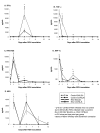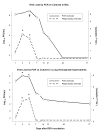Respiratory syncytial virus-induced acute and chronic airway disease is independent of genetic background: an experimental murine model
- PMID: 15916706
- PMCID: PMC1183251
- DOI: 10.1186/1743-422X-2-46
Respiratory syncytial virus-induced acute and chronic airway disease is independent of genetic background: an experimental murine model
Abstract
Background: Respiratory syncytial virus (RSV) is the leading respiratory viral pathogen in young children worldwide. RSV disease is associated with acute airway obstruction (AO), long-term airway hyperresponsiveness (AHR), and chronic lung inflammation. Using two different mouse strains, this study was designed to determine whether RSV disease patterns are host-dependent. C57BL/6 and BALB/c mice were inoculated with RSV and followed for 77 days. RSV loads were measured by plaque assay and polymerase chain reaction (PCR) in bronchoalveolar lavage (BAL) and whole lung samples; cytokines were measured in BAL samples. Lung inflammation was evaluated with a histopathologic score (HPS), and AO and AHR were determined by plethysmography.
Results: Viral load dynamics, histopathologic score (HPS), cytokine concentrations, AO and long-term AHR were similar in both strains of RSV-infected mice, although RSV-infected C57BL/6 mice developed significantly greater AO compared with RSV-infected BALB/c mice on day 5. PCR detected RSV RNA in BAL samples of RSV infected mice until day 42, and in whole lung samples through day 77. BAL concentrations of cytokines TNF-alpha, IFN-gamma, and chemokines MIG, RANTES and MIP-1alpha were significantly elevated in both strains of RSV-infected mice compared with their respective controls. Viral load measured by PCR significantly correlated with disease severity on days 14 and 21.
Conclusion: RSV-induced acute and chronic airway disease is independent of genetic background.
Figures


 ) and RSV inoculated (
) and RSV inoculated ( ) BALB/c mice, and sham inoculated (
) BALB/c mice, and sham inoculated ( ) and RSV inoculated (
) and RSV inoculated ( ) C57BL/6 mice from days 14 to 77. Values represent the mean SEM from 10–30 mice per group. Data shown are the result of four separate experiments. p < 0.05, comparison by t-test when data normally distributed, or by Mann-Whitney Rank sum test when data were not normally distributed.
) C57BL/6 mice from days 14 to 77. Values represent the mean SEM from 10–30 mice per group. Data shown are the result of four separate experiments. p < 0.05, comparison by t-test when data normally distributed, or by Mann-Whitney Rank sum test when data were not normally distributed.





References
-
- Sigurs N, Bjarnason R, Sigurbergsson F, Kjellman B. Respiratory syncytial virus bronchiolitis in infancy is an important risk factor for asthma and allergy at age 7. Am J Respir Crit Care Med. 2000;161:1501–1507. - PubMed
Publication types
MeSH terms
Substances
LinkOut - more resources
Full Text Sources
Medical
Research Materials

